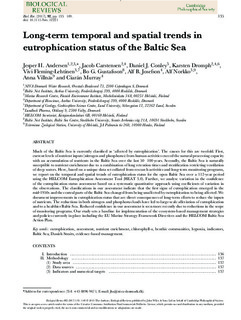| dc.contributor.author | Andersen, Jesper Harbo | |
| dc.contributor.author | Carstensen, Jacob | |
| dc.contributor.author | Conley, Daniel | |
| dc.contributor.author | Dromph, Karsten | |
| dc.contributor.author | Fleming-Lehtinen, Vivi | |
| dc.contributor.author | Gustavsson, Bo G. | |
| dc.contributor.author | Josefson, Alf B. | |
| dc.contributor.author | Norkko, Alf | |
| dc.contributor.author | Villnäs, Anna | |
| dc.contributor.author | Murray, Ciarán | |
| dc.date.accessioned | 2018-09-04T12:11:17Z | |
| dc.date.available | 2018-09-04T12:11:17Z | |
| dc.date.created | 2016-01-28T09:41:21Z | |
| dc.date.issued | 2015 | |
| dc.identifier.citation | Biological Reviews. 2015, 92 (1), 135-149. | nb_NO |
| dc.identifier.issn | 1464-7931 | |
| dc.identifier.uri | http://hdl.handle.net/11250/2560732 | |
| dc.description.abstract | Much of the Baltic Sea is currently classified as ‘affected by eutrophication’. The causes for this are twofold. First, current levels of nutrient inputs (nitrogen and phosphorus) from human activities exceed the natural processing capacity with an accumulation of nutrients in the Baltic Sea over the last 50–100 years. Secondly, the Baltic Sea is naturally susceptible to nutrient enrichment due to a combination of long retention times and stratification restricting ventilation of deep waters. Here, based on a unique data set collated from research activities and long-term monitoring programs, we report on the temporal and spatial trends of eutrophication status for the open Baltic Sea over a 112-year period using the HELCOM Eutrophication Assessment Tool (HEAT 3.0). Further, we analyse variation in the confidence of the eutrophication status assessment based on a systematic quantitative approach using coefficients of variation in the observations. The classifications in our assessment indicate that the first signs of eutrophication emerged in the mid-1950s and the central parts of the Baltic Sea changed from being unaffected by eutrophication to being affected. We document improvements in eutrophication status that are direct consequences of long-term efforts to reduce the inputs of nutrients. The reductions in both nitrogen and phosphorus loads have led to large-scale alleviation of eutrophication and to a healthier Baltic Sea. Reduced confidence in our assessment is seen more recently due to reductions in the scope of monitoring programs. Our study sets a baseline for implementation of the ecosystem-based management strategies and policies currently in place including the EU Marine Strategy Framework Directives and the HELCOM Baltic Sea Action Plan. | nb_NO |
| dc.language.iso | eng | nb_NO |
| dc.publisher | Wiley | nb_NO |
| dc.rights | Attribution-NonCommercial-NoDerivatives 4.0 Internasjonal | * |
| dc.rights.uri | http://creativecommons.org/licenses/by-nc-nd/4.0/deed.no | * |
| dc.title | Long-term temporal and spatial trends in eutrophication status of the Baltic Sea | nb_NO |
| dc.title.alternative | Long-term temporal and spatial trends in eutrophication status of the Baltic Sea | nb_NO |
| dc.type | Journal article | nb_NO |
| dc.type | Peer reviewed | nb_NO |
| dc.description.version | publishedVersion | nb_NO |
| dc.rights.holder | © 2015 The Authors. | nb_NO |
| dc.source.pagenumber | 135-149 | nb_NO |
| dc.source.volume | 92 | nb_NO |
| dc.source.journal | Biological Reviews | nb_NO |
| dc.source.issue | 1 | nb_NO |
| dc.identifier.doi | 10.1111/brv.12221 | |
| dc.identifier.cristin | 1324703 | |
| dc.relation.project | Wallenbergstiftelsen: * | nb_NO |
| dc.relation.project | Andre: WATERS | nb_NO |
| dc.relation.project | Andre: COCOA | nb_NO |
| dc.relation.project | Andre: Naturstyrelsen: 4303-00017 | nb_NO |
| dc.relation.project | Andre: DEVOTES | nb_NO |
| dc.relation.project | Andre: HELCOM: TARGREV | nb_NO |
| dc.relation.project | Andre: HYPER | nb_NO |
| cristin.unitcode | 7464,60,0,0 | |
| cristin.unitname | NIVA Danmark | |
| cristin.ispublished | true | |
| cristin.fulltext | original | |
| cristin.qualitycode | 2 | |

